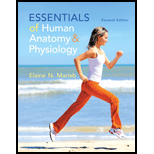
Essentials of Human Anatomy & Physiology (11th Edition)
11th Edition
ISBN: 9780321919007
Author: Elaine N. Marieb
Publisher: PEARSON
expand_more
expand_more
format_list_bulleted
Question
Chapter 2, Problem 27SAE
Summary Introduction
To review:
The meaning of electrolytes. Salts, acids, as well as bases are the electrolytes.
Introduction:
The substances that release the H+ (hydrogen ions) when dissolved in water are known as acids. Their potential of hydrogen (pH) is below 7. The bases are the substances, which release hydroxyl ions
Expert Solution & Answer
Want to see the full answer?
Check out a sample textbook solution
Students have asked these similar questions
A 25-year-old woman presents to the emergency department with a 2-day history of fever, chills, severe headache, and confusion. She recently returned from a trip to sub-Saharan Africa, where she did not take malaria prophylaxis. On examination, she is febrile (39.8°C/103.6°F) and hypotensive. Laboratory studies reveal hemoglobin of 8.0 g/dL, platelet count of 50,000/μL, and evidence of hemoglobinuria. A peripheral blood smear shows ring forms and banana-shaped gametocytes. Which of the following Plasmodium species is most likely responsible for her severe symptoms?
A.
Plasmodium vivax
B.
Plasmodium ovale
C.
Plasmodium malariae
D.
Plasmodium falciparum
Standard Concentration (caffeine) mg/L
Absorbance Reading
10
0.322
20
0.697
40
1.535
60
2.520
80
3.100
Please draw in the missing answer, thank you
Chapter 2 Solutions
Essentials of Human Anatomy & Physiology (11th Edition)
Ch. 2 - Prob. 1MCCh. 2 - Prob. 2MCCh. 2 - Prob. 3MCCh. 2 - Prob. 4MCCh. 2 - Glucose is to starch as a. a steroid is to a...Ch. 2 - 6. What lipid type is stored in fat deposits...Ch. 2 - Absence of which of the following...Ch. 2 - ATP is not associated with a. a basic nucleotide...Ch. 2 - Prob. 9MCCh. 2 - 10. Factors that increase the speed of chemical...
Ch. 2 - Why is a study of basic chemistry essential to...Ch. 2 - Matter occupies space and has mass. Explain how...Ch. 2 - Prob. 13SAECh. 2 - Prob. 14SAECh. 2 - Prob. 15SAECh. 2 - Prob. 16SAECh. 2 - All atoms are neutral. Explain the basis of this...Ch. 2 - Fill in the following table to fully describe an...Ch. 2 - Define radioactivity. If an element has three...Ch. 2 - Prob. 20SAECh. 2 - Prob. 21SAECh. 2 - Where would you expect to Find hydrogen bonds in...Ch. 2 - The two oxygen atoms forming molecules of oxygen...Ch. 2 - Prob. 24SAECh. 2 - 25. Identify each of the following reactions as a...Ch. 2 - Prob. 26SAECh. 2 - Prob. 27SAECh. 2 - 28. Define pH. The pH range of blood is from 7.35...Ch. 2 - Prob. 29SAECh. 2 - Prob. 30SAECh. 2 - Describe the structural differences between...Ch. 2 - Prob. 32SAECh. 2 - 33. Name the two protein classes based on...Ch. 2 - Prob. 34SAECh. 2 - Describe what has happened to a proteins structure...Ch. 2 - Prob. 36SAECh. 2 - Prob. 37SAECh. 2 - 38. Explain why you can “stack” water slightly...Ch. 2 - Explain what is meant by the terms synthesis...Ch. 2 - 41. Several antibiotics act by binding to certain...Ch. 2 - 42. Mrs. Roberts, who is in a diabetic coma, has...Ch. 2 - Tendons, ligaments, and skin contain a large...Ch. 2 - Prob. 43CAQ
Knowledge Booster
Learn more about
Need a deep-dive on the concept behind this application? Look no further. Learn more about this topic, biology and related others by exploring similar questions and additional content below.Similar questions
- a. On this first grid, assume that the DNA and RNA templates are read left to right. DNA DNA mRNA codon tRNA anticodon polypeptide _strand strand C с A T G A U G C A TRP b. Now do this AGAIN assuming that the DNA and RNA templates are read right to left. DNA DNA strand strand C mRNA codon tRNA anticodon polypeptide 0 A T G A U G с A TRParrow_forwardplease answer all question below with the following answer choice, thank you!arrow_forwardplease draw in the answeres, thank youarrow_forward
- A) What is being shown here?B) What is indicated by the RED arrow?C) What is indicated by the BLUE arrow?arrow_forwardPlease identify the curve shown below. What does this curve represent? Please identify A, B, C, D, and E (the orange oval). What is occurring in these regions?arrow_forwardPlease identify the test shown here. 1) What is the test? 2) What does the test indicate? How is it performed? What is CX? 3) Why might the test be performed in a clinical setting? GEN CZ CX CPZ PTZ CACarrow_forward
- Determine how much ATP would a cell produce when using fermentation of a 50 mM glucose solution?arrow_forwardDetermine how much ATP would a cell produce when using aerobic respiration of a 7 mM glucose solution?arrow_forwardDetermine how much ATP would a cell produce when using aerobic respiration to degrade one small protein molecule into 12 molecules of malic acid, how many ATP would that cell make? Malic acid is an intermediate in the Krebs cycle. Assume there is no other carbon source and no acetyl-CoA.arrow_forward
arrow_back_ios
SEE MORE QUESTIONS
arrow_forward_ios
Recommended textbooks for you
 Biology (MindTap Course List)BiologyISBN:9781337392938Author:Eldra Solomon, Charles Martin, Diana W. Martin, Linda R. BergPublisher:Cengage Learning
Biology (MindTap Course List)BiologyISBN:9781337392938Author:Eldra Solomon, Charles Martin, Diana W. Martin, Linda R. BergPublisher:Cengage Learning
 Human Biology (MindTap Course List)BiologyISBN:9781305112100Author:Cecie Starr, Beverly McMillanPublisher:Cengage Learning
Human Biology (MindTap Course List)BiologyISBN:9781305112100Author:Cecie Starr, Beverly McMillanPublisher:Cengage Learning

Biology (MindTap Course List)
Biology
ISBN:9781337392938
Author:Eldra Solomon, Charles Martin, Diana W. Martin, Linda R. Berg
Publisher:Cengage Learning



Human Biology (MindTap Course List)
Biology
ISBN:9781305112100
Author:Cecie Starr, Beverly McMillan
Publisher:Cengage Learning


GCSE Chemistry - Acids and Bases #34; Author: Cognito;https://www.youtube.com/watch?v=vt8fB3MFzLk;License: Standard youtube license